Users Online
· Guests Online: 18
· Members Online: 0
· Total Members: 188
· Newest Member: meenachowdary055
· Members Online: 0
· Total Members: 188
· Newest Member: meenachowdary055
Forum Threads
Newest Threads
No Threads created
Hottest Threads
No Threads created
Latest Articles
FAQ: Big Data Storage Patterns
| FAQ (Frequently Asked Questions) >Big Data Storage Patterns |
4_1. What do you understand by Big Data Storage Pattens
Since data is now more than just plain text, it can exist in various persistence-storage mechanisms, with Hadoop
distributed file system (HDFS) being one of them. The way data is ingested or the sources from which data is ingested
affects the way data is stored. On the other hand, how the data is pushed further into the downstream systems or
accessed by the data access layer decides how the data is to be stored.
The need to store huge volumes of data has forced databases to follow new rules of data relationships and
integrity that are different from those of relational database management systems (RDBMS).
RDBMS follow the ACID rules of atomicity, consistency, isolation and durability. These rules make the database
reliable to any user of the database. However, searching huge volumes of big data and retrieving data from them
would take large amounts of time if all the ACID rules were enforced.
A typical scenario is when we search for a certain topic using Google. The search returns innumerable pages of
data; however, only one page is visible or basically available (BA). The rest of the data is in a soft state (S) and is still
being assembled by Google, though the user is not aware of it. By the time the user looks at the data on the first page,
the rest of the data becomes eventually consistent (E). This phenomenonbasically available soft state and eventually
consistentis the rule followed by the big data databases, which are generally NoSQL databases following BASE
properties.
Database theory suggests that any distributed NoSQL big database can satisfy only two properties predominantly
and will have to relax standards on the third. The three properties are consistency, availability, and partition tolerance
(CAP). This is the CAP theorem.
The aforementioned paradigms of ACID, BASE, and CAP give rise to new big data storage patterns (Figure 4-1)
like the following:
Façade pattern: HDFS serves as the intermittent façade for the traditional DW systems.
Lean pattern: HBase is indexed using only one column-family and only one column and
unique row-key.
NoSQL pattern: Traditional RDBMS systems are replaced by NoSQL alternatives to facilitate
faster access and querying of big data.
Polyglot pattern: Multiple types of storage mechanismslike RDBMS, file storage, CMS, OODBMS, NoSQL and HDFSco-exist in an interprise to solve the big data problem.

Top
Since data is now more than just plain text, it can exist in various persistence-storage mechanisms, with Hadoop
distributed file system (HDFS) being one of them. The way data is ingested or the sources from which data is ingested
affects the way data is stored. On the other hand, how the data is pushed further into the downstream systems or
accessed by the data access layer decides how the data is to be stored.
The need to store huge volumes of data has forced databases to follow new rules of data relationships and
integrity that are different from those of relational database management systems (RDBMS).
RDBMS follow the ACID rules of atomicity, consistency, isolation and durability. These rules make the database
reliable to any user of the database. However, searching huge volumes of big data and retrieving data from them
would take large amounts of time if all the ACID rules were enforced.
A typical scenario is when we search for a certain topic using Google. The search returns innumerable pages of
data; however, only one page is visible or basically available (BA). The rest of the data is in a soft state (S) and is still
being assembled by Google, though the user is not aware of it. By the time the user looks at the data on the first page,
the rest of the data becomes eventually consistent (E). This phenomenonbasically available soft state and eventually
consistentis the rule followed by the big data databases, which are generally NoSQL databases following BASE
properties.
Database theory suggests that any distributed NoSQL big database can satisfy only two properties predominantly
and will have to relax standards on the third. The three properties are consistency, availability, and partition tolerance
(CAP). This is the CAP theorem.
The aforementioned paradigms of ACID, BASE, and CAP give rise to new big data storage patterns (Figure 4-1)
like the following:
Façade pattern: HDFS serves as the intermittent façade for the traditional DW systems.
Lean pattern: HBase is indexed using only one column-family and only one column and
unique row-key.
NoSQL pattern: Traditional RDBMS systems are replaced by NoSQL alternatives to facilitate
faster access and querying of big data.
Polyglot pattern: Multiple types of storage mechanismslike RDBMS, file storage, CMS, OODBMS, NoSQL and HDFSco-exist in an interprise to solve the big data problem.

Top
4_10. Can multiple storage mechanisms like RDBMS, Hadoop, and big data appliances co-exist in a solutiona scenario known as Polyglot Persistence?
Polyglot Pattern
Certainly. Because the type of data to be stored by an application has changed from being text to other unstructured formats, data can be persisted in multiple sources, like RDBMS, Content Management Systems (CMS), and Hadoop.
As seen in Figure 4-16, for a single application and for various use cases, the storage mechanism changes from traditional RDBMS to a key-value store to a NoSQL database to a CMS system. This contrasts with the traditional view of storing all application data in one single storage mechanism.

Top
Polyglot Pattern
Certainly. Because the type of data to be stored by an application has changed from being text to other unstructured formats, data can be persisted in multiple sources, like RDBMS, Content Management Systems (CMS), and Hadoop.
As seen in Figure 4-16, for a single application and for various use cases, the storage mechanism changes from traditional RDBMS to a key-value store to a NoSQL database to a CMS system. This contrasts with the traditional view of storing all application data in one single storage mechanism.

Top
4_11. What role do infrastructure vendors play in the Hadoop implementation?
As per the IDC (http://www.idc.com/getdoc.jsp?containerId=IDC_P25990), the following are the major vendors:
Storage vendors (incumbents): Dell, EMC, HP, IBM, NetApp, and Oracle
Storage vendors (upcoming): Amplidata, Cleversafe, Compuverde, Coraid, DDN, Nexsan,
Nimble, Nimbus, and Violin Memory
Because Hadoop is about distributed storage and analysis, infrastructure vendors play a major role. Vendors like Oracle, EMC and IBM have started packaging infrstructure apart from their big data appliance as part of their Hadoop solutions. The only advantage of such solutions is that the client has to be concerned about only a single vendor. But, again, there is a concern of a being locked to a single vendor and that migrating or decoupling individual entities of a Hadoop ecosystem might become too costly for the client. Due diligence and a total cost of ownership (TCO) assessment needs to be thoroughly done before opting for such a packaged solution.
Top
As per the IDC (http://www.idc.com/getdoc.jsp?containerId=IDC_P25990), the following are the major vendors:
Storage vendors (incumbents): Dell, EMC, HP, IBM, NetApp, and Oracle
Storage vendors (upcoming): Amplidata, Cleversafe, Compuverde, Coraid, DDN, Nexsan,
Nimble, Nimbus, and Violin Memory
Because Hadoop is about distributed storage and analysis, infrastructure vendors play a major role. Vendors like Oracle, EMC and IBM have started packaging infrstructure apart from their big data appliance as part of their Hadoop solutions. The only advantage of such solutions is that the client has to be concerned about only a single vendor. But, again, there is a concern of a being locked to a single vendor and that migrating or decoupling individual entities of a Hadoop ecosystem might become too costly for the client. Due diligence and a total cost of ownership (TCO) assessment needs to be thoroughly done before opting for such a packaged solution.
Top
4_12. What is a typical data-node configuration?
Per information from Intel (www.intel.com/bigdata), Figure 4-17 shows the configuration of the data node.
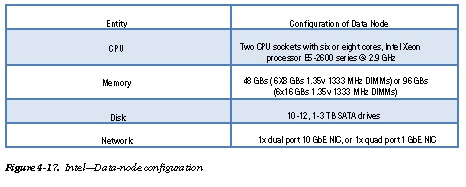
Figure 4-18 shows the same information for the IBM Big Data Networked Storage Solution for Hadoop
(http://www.redbooks.ibm.com/redpapers/pdfs/redp5010.pdf).
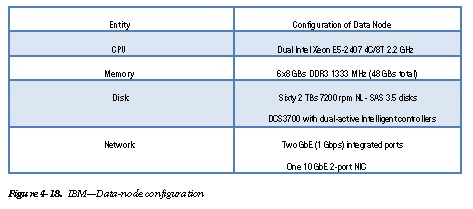
Top
Per information from Intel (www.intel.com/bigdata), Figure 4-17 shows the configuration of the data node.

Figure 4-18 shows the same information for the IBM Big Data Networked Storage Solution for Hadoop
(http://www.redbooks.ibm.com/redpapers/pdfs/redp5010.pdf).

Top
4_2. Does big data replace existing data warehouse (DW) implementations?
Hadoop is not necessarily a replacement for a data warehouse (DW). It can also act as façade for a DW (Figure 4-2 and Figure 4-3). Data from different sources can be aggregated into an HDFS before being transformed and loaded to the traditional DW and business intelligence (BI) tools.
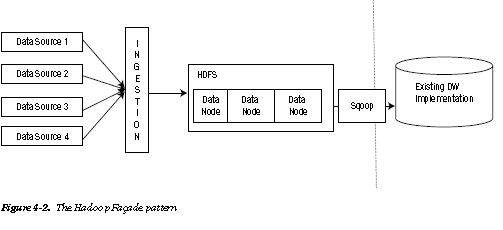

This helps in retaining the investment in the existing DW framework, as well as the data usage in the downstream systems. This also helps re-use the existng infrastructure and add an abstraction of the DW. Hence, if new data sources are added to the ingestion system, it is still abstracted from the DW framework. This pattern solves the variety challenge among the three Vs (velocity, variety, and volume) of big data as shown in the example in Figures 4-3 to 4-6.
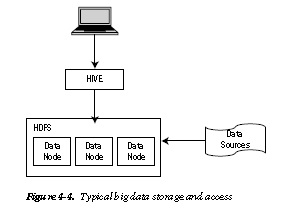
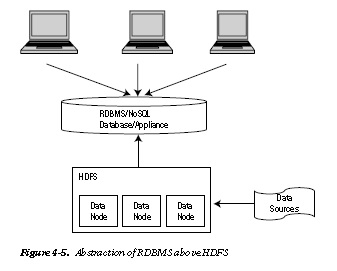

Data can be stored as structured data after being ingested into HDFS in the form of storage in an RDBMS (Figure 4-5) or in the form of applicances like IBM Netezza/EMC Greenplum, NoSQL Databases like Cassandra/HO Vertica/Oracle Exadata, or simply in an in-memory cache (Figure 4-6).
This ensures that only necessary data resides in the structured storage, thereby reducing the data size as well as latency (while accessing the data).
Top
Hadoop is not necessarily a replacement for a data warehouse (DW). It can also act as façade for a DW (Figure 4-2 and Figure 4-3). Data from different sources can be aggregated into an HDFS before being transformed and loaded to the traditional DW and business intelligence (BI) tools.


This helps in retaining the investment in the existing DW framework, as well as the data usage in the downstream systems. This also helps re-use the existng infrastructure and add an abstraction of the DW. Hence, if new data sources are added to the ingestion system, it is still abstracted from the DW framework. This pattern solves the variety challenge among the three Vs (velocity, variety, and volume) of big data as shown in the example in Figures 4-3 to 4-6.



Data can be stored as structured data after being ingested into HDFS in the form of storage in an RDBMS (Figure 4-5) or in the form of applicances like IBM Netezza/EMC Greenplum, NoSQL Databases like Cassandra/HO Vertica/Oracle Exadata, or simply in an in-memory cache (Figure 4-6).
This ensures that only necessary data resides in the structured storage, thereby reducing the data size as well as latency (while accessing the data).
Top
4_3. What are the benefits of using an integrated big data appliance?
Data Appliances
The types of big data appliances claiming to offer high performance and low latency have mushroomed in the market.
We need to be aware how they really affect the existing infrastructure and the benefits that these appliances bring to the table.
HP Vertica, IBM Netezza, Oracle Exadata, and EMC Greenplum are packaged, commercial off-the-shelf COTS
appliances available in the market. The advantage of such appliances is that they bring together the infrastructure,
the Hadoop firmware, and management tools (for managing the Hadoop nodes). These appliances also ensure that
instead of aligning with multiple vendors for software, storage and tools, only a tie-up with a single vendor is needed.
This reduces considerable legwork for the client, ensuring the client deals with a single vendor for all issues.
HP Vertica (Figure 4-7) is an example of an all-in-one appliance.
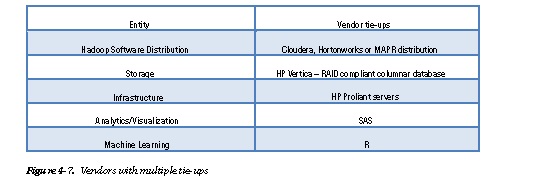
As you can see from the preceding example, the HP big data implementation brings with it back-to-back
collaboration with other vendors. Other examples are shown in Figure 4-8.

For one financial firm, a shift from a relational database to an appliance saw a 270 times faster query run. So the difference can be quite substantial.
The points to consider before implementing an appliance are these:
Vendor lock-in
Time to bring appliance implementation into production (porting data from legacy
applications to appliance)
Skills and expertise availability
License cost
Annual maintenance cost
Total cost of ownership (TCO)
Return on investment (ROI)
Business case or the need for performance improvements over the existing Hadoop
implementation
Security (encryption and authentication)
Integration with existing tools and hardware
Top
Data Appliances
The types of big data appliances claiming to offer high performance and low latency have mushroomed in the market.
We need to be aware how they really affect the existing infrastructure and the benefits that these appliances bring to the table.
HP Vertica, IBM Netezza, Oracle Exadata, and EMC Greenplum are packaged, commercial off-the-shelf COTS
appliances available in the market. The advantage of such appliances is that they bring together the infrastructure,
the Hadoop firmware, and management tools (for managing the Hadoop nodes). These appliances also ensure that
instead of aligning with multiple vendors for software, storage and tools, only a tie-up with a single vendor is needed.
This reduces considerable legwork for the client, ensuring the client deals with a single vendor for all issues.
HP Vertica (Figure 4-7) is an example of an all-in-one appliance.

As you can see from the preceding example, the HP big data implementation brings with it back-to-back
collaboration with other vendors. Other examples are shown in Figure 4-8.

For one financial firm, a shift from a relational database to an appliance saw a 270 times faster query run. So the difference can be quite substantial.
The points to consider before implementing an appliance are these:
Vendor lock-in
Time to bring appliance implementation into production (porting data from legacy
applications to appliance)
Skills and expertise availability
License cost
Annual maintenance cost
Total cost of ownership (TCO)
Return on investment (ROI)
Business case or the need for performance improvements over the existing Hadoop
implementation
Security (encryption and authentication)
Integration with existing tools and hardware
Top
4_4. Should big data be stored on RAID-configured disks?
Storage Disks
SAN, NAS, and SSD are some well-known storage formats. Big data has been tested on SAN disks, but there is not much performance data available regarding SSD.
RAID configuration is not necessary if the default storage is HDFS, because it already has a replication mechanism.
Some appliances, including some of those discussed earlier, abstract the data that needs to be analyzed into a structured format that might have to be RAID-configured.
Top
Storage Disks
SAN, NAS, and SSD are some well-known storage formats. Big data has been tested on SAN disks, but there is not much performance data available regarding SSD.
RAID configuration is not necessary if the default storage is HDFS, because it already has a replication mechanism.
Some appliances, including some of those discussed earlier, abstract the data that needs to be analyzed into a structured format that might have to be RAID-configured.
Top
4_5. Is there a time-to-live for data to reside in HDFS?
Data Archive/Purge
Yes, as in any storage solution, data needs to be persisted only as long as the business demands it. Beyond this period, the data can be archived to products like EMC Isilon (http://www.emc.com/archiving/archive-big-data.htm).
A data purge also has to be business driven.
Top
Data Archive/Purge
Yes, as in any storage solution, data needs to be persisted only as long as the business demands it. Beyond this period, the data can be archived to products like EMC Isilon (http://www.emc.com/archiving/archive-big-data.htm).
A data purge also has to be business driven.
Top
4_6. HDFS is a distributed file system and inherently splits a file into chunks and replicates them. Does it still need further partitioning and indexing?
Data Partitioning/Indexing and the Lean Pattern
As a best practice, data partitioning is recommended for HDFS-based NoSQL databases. Because HDFS is a folder
structure, data can be distributed/partitioned in multiple folders that are created on the basis of time-stamp, geography, or any other parameters that drive the business. This ensures that data access is capable of very high performance.
Top
Data Partitioning/Indexing and the Lean Pattern
As a best practice, data partitioning is recommended for HDFS-based NoSQL databases. Because HDFS is a folder
structure, data can be distributed/partitioned in multiple folders that are created on the basis of time-stamp, geography, or any other parameters that drive the business. This ensures that data access is capable of very high performance.
Top
4_7. Is data indexing possible in HDFS (the Lean pattern)?
Data indexing as known in the RDBMS world is not applicable to HDFS but is applicable to NoSQL databases, like HBase, that are HDFS aware and compliant.
HBase works on the concept of column-family apart from columns, which can be leveraged to aggregate similar data together (Figures 4-9 and 4-10).


As you can see in the preceding illustrations, there are three ways a dataset can be uniquely identified. A unique combination of column-family name and a column can be used to uniquely identify a dataset. This can be achieved by having a combination of one-column or multiple-column families. A third way is to create a unique row-key, while having only a one column-family and one column. This implementation is called a Lean pattern implementation (Figure 4-11). The row-key name should end with a suffix of a time-stamp.

This not only helps create a unique row-key but also helps in filtering or sorting data because the suffix is
numeric in the form of a time-stamp.
Since maintenance can be difficult if the Lean pattern is implemented, it should be chosen over the other two only if the right skills and expertise exist in the big data team.
Top
Data indexing as known in the RDBMS world is not applicable to HDFS but is applicable to NoSQL databases, like HBase, that are HDFS aware and compliant.
HBase works on the concept of column-family apart from columns, which can be leveraged to aggregate similar data together (Figures 4-9 and 4-10).


As you can see in the preceding illustrations, there are three ways a dataset can be uniquely identified. A unique combination of column-family name and a column can be used to uniquely identify a dataset. This can be achieved by having a combination of one-column or multiple-column families. A third way is to create a unique row-key, while having only a one column-family and one column. This implementation is called a Lean pattern implementation (Figure 4-11). The row-key name should end with a suffix of a time-stamp.

This not only helps create a unique row-key but also helps in filtering or sorting data because the suffix is
numeric in the form of a time-stamp.
Since maintenance can be difficult if the Lean pattern is implemented, it should be chosen over the other two only if the right skills and expertise exist in the big data team.
Top
4_8. Are there other publicly available big data storage mechanisms?
HDFS Alternatives
Amazon Web Services (AWS) has its own storage mechanism in the form of S3. Data can be stored in S3 in the form of buckets. Whether all the data resides in a single bucket or in multiple buckets, again, should be driven by business needs and/or the skills available in the organization.
Other vendors, like IBM (GPFS) and EMC (Figure 4-12), have also been marketing their own file systems, but not many industry credentials are present to make them serious contenders to HDFS.

MapR claims to have a file system two times faster than HDFS. (See Link) However, clients would be reluctant to have a vendor lock-in at the file level. Migrating from a MapR Hadoop distribution to a Cloudera or a Hortonworks distribution will surely result in different performance statistics.
Top
HDFS Alternatives
Amazon Web Services (AWS) has its own storage mechanism in the form of S3. Data can be stored in S3 in the form of buckets. Whether all the data resides in a single bucket or in multiple buckets, again, should be driven by business needs and/or the skills available in the organization.
Other vendors, like IBM (GPFS) and EMC (Figure 4-12), have also been marketing their own file systems, but not many industry credentials are present to make them serious contenders to HDFS.

MapR claims to have a file system two times faster than HDFS. (See Link) However, clients would be reluctant to have a vendor lock-in at the file level. Migrating from a MapR Hadoop distribution to a Cloudera or a Hortonworks distribution will surely result in different performance statistics.
Top
4_9. What role do NoSQL databases play in the Hadoop implementation?
NoSQL Pattern
NoSQL databases can store data on local NFS disks as well as HDFS. NoSQL databases are HDFS-aware; hence, data can be distributed across Hadoop data nodes and, at the same time, data can be easily accessed because it is stored in a nonrelational, columnar fashion. As we have discussed there are four types of NoSQL databases. Figure 4-13 lists their major big data use cases. Vendor implementations of NoSQL subsequently became open source implementations as seen in Figure 4-14.


Scenarios for NoSQL:
N+1 Selects problem for a large dataset
Writing a huge amount of data
Semi structured data
You should investigate NoSQL technologies to determine which offerings best fit your needs.
As mentioned, NoSQL databases allow faster searching on huge unstructured data.
Key-value pair databases store data as simple key-value pairs. The keys are unique and do not have any foreign keys or constraints. They are suitable for parallel lookups because the data sources have no relationships among each other. As you can imagine, such a structure is good for high read access. Due to a lack of referential integrity, the data integrity has to be managed by the front-end applications.
Column-oriented databases have a huge number of columns for each tuple. Each column also has a column key.
Related columns have a column-family qualifier so that they can be retrieved together during a search. Because each column also has a column key, these databases are suitable for fast writes.
Document databases store text, media, and JSON or XML data. The value in a row is a blob of the aforementioned data and can be retrieved using a key. If you want to search through multiple documents for a specific string, a document database should be used.
Graph databases store data entities and connections between them as nodes and edges. They are similar to a network database and can be used to calculate shortest paths, social network analysis, and other parameters.
Figure 4-15 depicts a NoSQL application pattern, where HBASE (which is a columnar data store) is used to store log-file data and then accessed by the front-end application to search for patterns or specific occurrences of certain strings.

Top
NoSQL Pattern
NoSQL databases can store data on local NFS disks as well as HDFS. NoSQL databases are HDFS-aware; hence, data can be distributed across Hadoop data nodes and, at the same time, data can be easily accessed because it is stored in a nonrelational, columnar fashion. As we have discussed there are four types of NoSQL databases. Figure 4-13 lists their major big data use cases. Vendor implementations of NoSQL subsequently became open source implementations as seen in Figure 4-14.


Scenarios for NoSQL:
N+1 Selects problem for a large dataset
Writing a huge amount of data
Semi structured data
You should investigate NoSQL technologies to determine which offerings best fit your needs.
As mentioned, NoSQL databases allow faster searching on huge unstructured data.
Key-value pair databases store data as simple key-value pairs. The keys are unique and do not have any foreign keys or constraints. They are suitable for parallel lookups because the data sources have no relationships among each other. As you can imagine, such a structure is good for high read access. Due to a lack of referential integrity, the data integrity has to be managed by the front-end applications.
Column-oriented databases have a huge number of columns for each tuple. Each column also has a column key.
Related columns have a column-family qualifier so that they can be retrieved together during a search. Because each column also has a column key, these databases are suitable for fast writes.
Document databases store text, media, and JSON or XML data. The value in a row is a blob of the aforementioned data and can be retrieved using a key. If you want to search through multiple documents for a specific string, a document database should be used.
Graph databases store data entities and connections between them as nodes and edges. They are similar to a network database and can be used to calculate shortest paths, social network analysis, and other parameters.
Figure 4-15 depicts a NoSQL application pattern, where HBASE (which is a columnar data store) is used to store log-file data and then accessed by the front-end application to search for patterns or specific occurrences of certain strings.

Top
